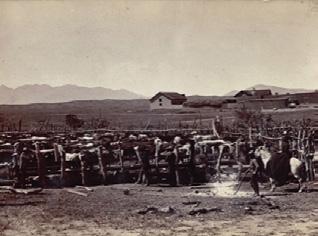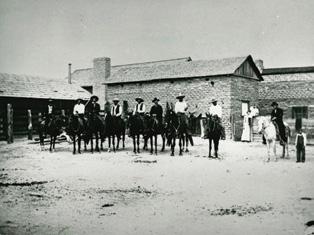
5 minute read
History
HISTORY: THE EMPIRE RANCH
Advertisement
ARTICLE BY JANE EPPINGA, PHOTOS COURTESY OF EMPIRE RANCH FOUNDATION
The Empire was homesteaded in the 1870’s, as a 160 acre ranch with a four-room adobe ranch house and adjoining adobe-walled corral. In 1876, Edward Nye Fish, a Tucson businessman, sold it for $2,000 to Walter L. Vail and Herbert Hislop. John Harvey joined the partnership a few months later.

Margaret Vail on sidesaddle in Empire Ranch upper corral. Ranch buildings in rear. 1880s
Over the next 20 years, Vail and various partners expanded the land holdings to include more than 100,000 acres. The Total Wreck silver mine, located in the Empire Mountains north of the ranch headquarters, was developed, adding to ranch prosperity. The house was expanded to more than 22-rooms and outbuildings and structures were added. The flat earthen roofs were replaced with wooden gable roofs.
In 1896, Walter Vail established his corporate headquarters in Los Angeles. Empire Ranch operations were overseen by Vail Company foremen until 1913 when William Banning Vail, Walter’s third oldest son, took over ranch management. He and his wife Laura Perry Vail, and their three children lived at the ranch until it was sold in 1928 to the Chiricahua Ranches Company (CRC). The CRC was incorporated by three Boice brothers, Henry Gudgell, Frank Seymour and Charles Gudgell, known for their promotion of the Hereford cattle. Frank and his wife, Mary Grantham Boice, moved to the Empire Ranch in 1929. Their sons, Stephen “Pancho” and Bob, grew up on the ranch and assisted with ranching operations.

Empire Ranch men who drove 900 cattle to California in 1890.
The Boices added modern conveniences including propane, natural gas, a large electric walk-in refrigeration unit, upgraded plumbing and they applied cement stucco to the exterior house walls. A swimming pool became the focal point for family gatherings and parties. Many Hollywood films were shot at the Empire Ranch and the Boices hosted numerous film stars, including John Wayne, when Red River was filmed at the ranch.
Corporate Era (1969-1988)
In 1969, the Boices sold the Empire Ranch to Gulf American Corporation (GAC) which planned to build a residential community development, and contracted with Pancho Boice to continue ranching under lease arrangements. In 1974, Anamax Mining Company purchased the Empire Ranch from GAC for its water rights and mineral potential.
The Empire Ranch is fortunate in that several of its cowboys and associates have left their memoirs. Mike Dojaquez arrived from Sonora Mexico in 1905 and worked at the Empire Ranch under the direction of foreman Tom Turner, a Santa Cruz County Sheriff. His son Henry worked roundup and helped Frank Boice build a dam on Cienega Creek. He recalled stories of the Fort Huachuca soldiers who camped at the ranch saving the ranch structures from fire. He described the farming operations, raising corn and alfalfa, at the Empire Ranch, and the supplies that were kept in the commissary. Families that worked for the ranch received monthly allotments of sugar, flour, coffee and fresh meat. Henry recalled experiences with the Civilian Conservation Corps, moonshine operations and other activities. Richard (Dick) Jimenez worked as a cowboy on the Empire Ranch from 1933 until 1945 when the Boices had about twelve steady cowboys; during a roundup they had about thirty. His wife Eva was raised on the Empire Ranch by her grandparents. Her grandfather, Mariano Ferra worked in the Rosemont area of the Empire, and in 1927 worked at the ranch headquarters. They lived in a small two-room adobe house known as the Hired Man’s House. When the Boices purchased the Empire in 1929 they allowed Eva’s grandparents to remain in the house. Eva helped Mary Boice with her children, and Mary’s beautiful gardens. As a girl Eva rode her horse, accompanied by her dog, Valente, to the Empire School on Greaterville Road. The ride took about two hours each way. Their teachers did not allow the students to speak Spanish, and she gave her drinking water to the dog.
One of the most colorful characters was the veterinarian Dr. James Pickrell who worked for the Boice family. Pickrell’s first involvement with the Empire Ranch as a veterinarian was when the foreman, Fred Barnett, asked him to castrate his horse. Until then the Empire Ranch had handled all of its own veterinary work. The ranch became his first account, and he worked on individual animals and handled their pregnancy testing. Pickrell noted that the Boices were excellent cattlemen. The Boice’s bred Hereford cattle and developed water sources such as dirt tanks so that the cattle would not have to travel far for water. The Boices approached ranching scientifically, Empire Ranch men who drove 900 cattle to California in 1890. keeping records of weight gain, etc. and collaborating with University of Arizona scientists. Pickrell dealt with cancer eye, pink eye, screwworms, pneumonia, poisoning by weeds or Johnson grass, colic and calving problems.

John Wayne with Pancho, Bob, and Mary Boice during filming of Red River, 1946.
Bureau of Land Management Era (1988-present)
In the 1980s, public support sought to preserve the ranch and its natural resources in their historic condition. In 1988, a series of land exchanges put the property into public ownership under the administration of the Bureau of Land Management (BLM). In 2000, the U.S. Congress officially designated 42,000 acres to be Las Cienegas National Conservation Area (LCNCA). BLM entered into a lease agreement with John Donaldson and his son Mac to continue ranching on the Empire Ranch, following modern ranching practices designed to preserve and monitor the LCNCA’s natural resources and accommodate public recreation. In 2009, the Tomlinson family, owners of the Vera Earl Ranch in Sonoita, assumed the Donaldson grazing lease and are ranching on the Empire Ranch today. BLM managers were committed to preserving the historic Empire Ranch headquarters buildings and interpreting them for future generations. Studies were undertaken to support and specify appropriate historic preservation.
Future
Work has already been completed on the main ranch house and the adobe hay barn. The ERF’s next big endeavor will be to raise funds for the stabilization of the New Ranch House which sits on a hill just north of the main ranch house. This house was built by Pancho Boice in the 1950’s and it will be rehabilitated into a conference/working space for the Foundation and other agencies for educational purposes.
Events
Free docent led tours are held the second and fourth Saturday of every month.
Volunteer Days are held the first Saturday in every month
Annual Spring Trail Ride, April 4, 2020
National Day of the Cowboy, July 25, 2020
Western Movie at the Loft in Tucson,
September 2020 (Date TBD) Empire Ranch
Cowboy Festival, November 7, 2020
Christmas at the Ranch, December 12, 2020










